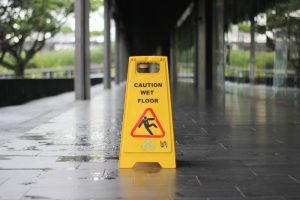
What can go wrong in offices? It’s a statement hardly ever muttered at the workplace, due to the nature of the environment. However, according to the Health and Safety Executive (HSE), statistics show that slips trips and falls, manual handling, awkward/tiring positions and keyboard work are estimated to be the main cause of work-related musculoskeletal disorders (affected areas: neck, limb and back injuries).
Here at FRS, we take health and safety very seriously, we feel that making you (as the reader) aware of the most common office hazards is the first step in eliminating them and reducing the odds of injuries occurring. HR can then work towards devising a process on how to identify such dangers and correct any problems.
Slips, trips and falls are the most common cause of injury at work, statistics show that up to 40% of all reported injuries can also lead to other types of serious accidents.
Coffee spillages, personal belongings left out on the hallway, indiscriminate weather conditions are all cause for concern, as these can manifest into hazards on office floors, walk ways, staircases and entry and exit areas. Preventative measures should be applied as soon as possible to reduce accidents being caused.
A successful risk assessment can make all the difference. HSE provides a great manual on this subject, putting control measures into practice immediately, think about what hazards can put others at risk, and you can do this by the following:
Sitting on a chair for 8-9 hours a day is not healthy, in fact human anatomy was not created for such positions. Working on a computer, or at a desk for long hours is not comfortable, and the body will re-adjust to try to become comfortable. However this is not healthy. Your shoulders fall forward and the back of your leg muscles become shorter creating an unhealthy posture.
You are legally advised to consult all your employees on ergonomic health and safety matters. This involves employers not only giving information to employees but also listening to them and taking account of what they say before making health and safety decisions.
We advise asking employees some specific questions regarding their work:
Staining at a screen all day is not good for the eyes and can cause eye strains, according to the NHS, during lockdown eye strain symptoms significantly increased, this is largely due to increased screen time.
In law, an employer must protect their workers from any harmful risks, this includes working with display screen equipment (DSE). A DSE assessment should be mandatory, and employers should look at:
If you’d like to find out more about a DSE assessment click here .
The NHS also advises preventative measures, they suggest following their 20/20 rule, this means that every 20 minutes, you should take a break from looking at your screen and look at something around 20 feet away, for at least 20 seconds, this helps combat drying out eyes.
Many fires are preventable, and adopting the right attitude and procedures can help avoid such dangers. All it takes is three things to start a fire, heat, something that burns, and oxygen. In an office all three are present, this means it’s a must to stop these 3 sources from mixing.
As an employer, you must carry out a fire safety risk assessment, and keep it up to date.
Based on the findings of the assessment, employers need to ensure that adequate and appropriate fire safety measures are in place to minimise the risk of injury or loss of life in the event of a fire.
The law says employers must make sure there’s an adequate supply of fresh air (ventilation) in enclosed areas. Quality ventilation is important, especially during the pandemic, ventilation helps reduce how much virus is in the air, helps reduce aerosol transmission and other respiratory disorders. Ensuring the efficiency of air quality should be taken into consideration, especially in overcrowded offices.
Providing adequate ventilation does not mean that employees must work in uncomfortably cold conditions. As an employer steps can be taken into consideration to ensure that ventilation needs are met.
This is just a brief discussion on Risk at work, if you’d like to learn more we have many courses ourselves in order to build your knowledge and get accredited.
Check our courses out, and if you’d like to discuss ways in which you can improve the health and safety of your workplace, don’t be afraid to contact us!
Call us today on 01179 866397 or get in touch today